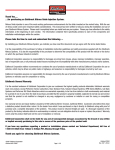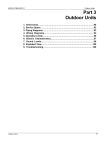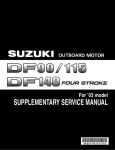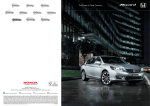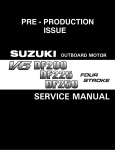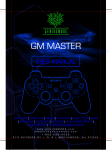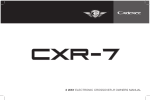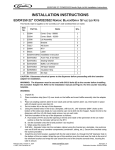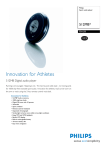Download Suzuki DF150 Brochure
Transcript
Fresh Ideas, Advanced Technology and Innovative Design Keep Suzuki Ahead of the Competition Unrivaled expertise, world-class technology, innovative ideas and design… That’s an excellent summary of what you can find in Suzuki’s line of four-stroke outboards, and the new DF150 and DF175. At Suzuki, our goal has always been to provide boaters with the power to get the most enjoyment from their boating experience. To that end, we have employed outside-the-box thinking, cutting edge technology, and refined designs to develop a line of four-stroke outboard motors unmatched by the competition. In so doing, Suzuki built the first fourstroke outboard with digital electronic fuel injection; created the first fourstroke outboard with a self-adjusting and maintenance-free timing chain; developed the first use of an offset drive shaft with two-stage mixed cam drive; and designed and built the world’s first 250 horsepower V6 four-stroke outboards. Our commitment to new and better ideas has earned us the respect of the industry and acclaim from satisfied customers. As proof, Suzuki has been awarded four NMMA awards for outboard innovation, not to mention the three “Editors Choice” awards from Motorboating Magazine. Now we are building on this heritage. Our new DF150 and DF175 four-stroke outboards are the most powerful four-cylinder outboards we have ever built. These new -compact and lightweight DF175 outboard motors provide the benefits of fuel efficiency and low emissions. More importantly, they expand on the potential of four-stroke power for marine applications by delivering powerful acceleration, quick throttle response and exhilarating topend speed. DF150 1 Big Block – High Performance Engine Suzuki’s DF150 and DF175 are based on an all-new inline four-cylinder DOHC powerhead with a 2,867cm3 (174.9 cu.in.) displacement—the largest to date in the four-stroke, four-cylinder category. While the added displacement contributes greatly to exceptional acceleration and velocity, it doesn’t mean that these engines are comparatively larger and heavier in size. To the contrary, Suzuki’s engineers have targeted these big block motors to be the lightest four-strokes of their kind. Taking advantage of advances Suzuki engineers have made in four-stroke engine performance, the DF175 utilizes a continuously variable valve timing system much like that found in our flagship DF250. Both the DF150 and DF175 share other advanced features including multi-stage induction and a 32-bit onboard computer that monitors and controls engine functions. Both outboards have also gained the CARB Three-Star rating, which identifies engines that meet the California Air Resources Board’s 2008 exhaust emissions standards. 2 ■ Advanced Technology for the Performance Torque Curve with VVT The new DF150 and DF175 utilize an all-new inline fourcylinder four-stroke engine with a DOHC four-valve powerhead that produces 150hp (110kW) and 175hp (129kW) respectively. At 2,867cm3 (174.9 cu.in.), these two outboards offer the largest displacement in the four-stroke, four-cylinder category to date. And thanks to Suzuki’s innovative engineering, they are the lightest in their category to date. TORQUE Largest Displacement in Their Class without VVT VVT (Variable Valve Timing) (DF175) In designing the DF175, our goal was to expand the potential of the four-stroke engine and create an outboard that delivers high performance along with the benefits of four-stroke technology. Like the flagship DF250, the DF175 is designed with an aggressive cam profile and paired with Suzuki’s advanced Variable Valve Timing (VVT) to increase the low to mid-range torque outboards need when accelerating. The intake valve actually starts to open before the exhaust valve fully closes, creating a momentary overlap in the timing where both valves are open. Using Variable Valve Timing, this overlap can be increased or decreased by altering intake timing with the camshaft, thereby optimizing camshaft timing for low and mid-range operation. LOW MID HIGH ENGINE SPEED * At the comparison test, Multi-Stage Induction System of the motor was operated. Air Flow in Multi-Stage Induction Module Lower rpm High rpm Multi-Stage Induction (MSI) Torque Curve Torque (with Multi-Stage Induction) TORQUE The DF150 and DF175 incorporate a multi-stage induction system to enhance engine performance by changing the length of intake manifold pipes according to engine speed. The system utilizes two intake manifold pipes per cylinder, one for operating at low engine speed and another for operating at high. At lower rpm, air enters the combustion chamber through the longer manifold pipe, which is designed to deliver an optimum volume of fresh air into the chamber to improve combustion and boost lowend torque. As the engine speed surpasses a preset threshold, the valve on the direct intake pipe opens up, letting air enter instantly into the combustion chamber. Shorter and lacking resistance, this pipe gets a greater volume of air into the chamber, increasing the engine’s ability to breathe at high rpm, thus improving high speed power output. Suzuki engineers have equipped these outboards with many other advanced features that contribute to engine performance. A spherical bore throttle body produces smoother airflow during acceleration. This results in greater engine control and stable operation at low rpm. Torque (without Multi-Stage Induction) LOW MID ENGINE SPEED 3 HIGH ■ Smooth Operation ■ Durability and Reliability Counter Balancer System Suzuki’s Anti-Corrosion Finish In-line four-cylinder engines operating at high RPMs generate a secondary vibration that is directionally in line with the pistons’ movement. In order to counter this vibration, Suzuki engineers utilize a secondary balancer system, which produces a horizontal motion against pistons’ movement. To produce this horizontal motion, the balancer is divided into left and right sections, each rotating in an opposite direction. Rotating at twice the speed of the crankshaft, the balancers effectively counter these secondary vibrations and produce a smoother operating engine. Suzuki’s anti-corrosion finish is specially formulated to increase the durability of the engine and protect those parts of the aluminum exterior that are constantly exposed to saltwater. Applied directly to the outboard’s aluminum alloy, this advanced finish provides maximum bonding of the outboard’s finish to its aluminum surface. Layered on top is an epoxy primer Acrylic Resin Clear Topcoat undercoat, black metallic finish, and Acrylic Resin Black Metallic Basecoat clear acrylic fiber Epoxy Primer finish that together Undercoat form an effective Suzuki AntiCorrosion Finish treatment against corrosion. Suzuki Aluminum Alloy Thrust Mount System In order to reduce vibration and provide stable operation, the DF150 and DF175 use a combination of two different rubber mount types. On both the upper and lower mounts, a combination of soft type and high thrust rubber mounts are utilized. The soft rubber mounts used in this configuration are designed to absorb vibrations produced in the idling through 2,000 rpm operating range. While adding to the compact design and providing an improvement in power and performance, this system also places the high thrust rubber mounts in the best position to provide stable operation under high loads. Enhanced Air Intake System Offset Drive Shaft Suzuki’s offset drive shaft has proven successful in reduction of size for the DF90, DF115, DF140, DF200, DF225, and DF250. The DF150 and DF175 benefit from this same design, which positions the crankshaft in front of the drive shaft, simultaneously moving the outboard’s center of gravity forward. While adding to the compactness of the outboard and providing an improvement in power performance, this system also places the engine’s axis of inertia, the point where vibrations produced by the engine are at a minimum, up over the upper engine mount thus, greatly reducing vibration. Quietness Comparison The DF150 and DF175 are powerful outboards, but powerful doesn’t mean that Brand A (2st D/I 175PS) they are noisy. Quiet operation has long been an integral part of Suzuki fourstroke outboard design. DF175 A comparison of engine operating noise levels between the four-stroke DF175 and its two-stroke direct fuel injection (D/I) counterpart is shown in the graph. In this comparison it rpm *According to Suzuki Internal Running Test is clear that the DF175 delivers quieter operation over its entire range than its two-stroke counterpart. 100 dB 90 80 70 60 50 LOW MID HIGH 4 Maximizing airflow into the engine is one way to gain maximum power output. The DF150 and DF175 are designed with a large air induction port to increase airflow into the engine. Air is channeled into a large silencer, then through the intake manifold, and finally into the cylinders via a high performance DOHC four-valve-per-cylinder head. The increased airflow results in more low- to mid-range torque and provides a wide powerband that is a must in an outboard engine. The system also includes a water separator which keeps water out of the air intake system. Offset Drive Shaft ■ Advanced Electronics Multi-Point Sequential Electronic Fuel injection 32-Bit ECM (Engine Control Module) The ECM (Engine Control Module) allows much more accurate control over the motor’s operation, particularly the engine’s ignition and fuel delivery systems. The DF150 and DF175 rely on a powerful 32-bit computer in the ECM to monitor and process crucial data, in real time, from a series of sensors placed in critical areas on the engine. This comprehensive network of sensors includes the Manifold Absolute Pressure Sensor, Crankshaft Position Sensor, Intake Air Temperature Sensor, Shift Position Sensor, Throttle Position Sensor, Cylinder Wall Temperature Sensor, Camshaft Position Sensor, and Exhaust Jacket Temperature Sensor. Processing this data in real time, the computer controls the engine’s ignition system and provides an ideal fuel supply under all operating conditions. As Suzuki was the first outboard motor manufacturer to incorporate multi-point sequential fuel injection in a four-stroke outboard, it is only natural that the DF150 and DF175 would utilize the same. The system injects the optimum amount of fuel at high pressure into each cylinder according to commands from the ECM’s 32-bit computer. Along with saving fuel, the system enables the DF150 and DF175 to meet the world’s strictest emissions regulations—CARB 2008—and pass the EPA’s 2006 regulations. Other benefits include quick starts, crisp acceleration, smooth performance, and maximum efficiency. Multi Point Sequential Electronic Fuel Injection Fuel Tank Low Pressure Fuel Filter Squeeze Pump Low Pressure Fuel Pump Vapor Separator Battery High Pressure Fuel Filter Float Flywheel Magneto Crankshaft Position Sensor (CKP Sensor) Shift Position Sensor High Pressure Fuel Pump Oil Control Valve (OCV) ECM Evaporation Hose Fuel Cooler Ignition Coil Pressure Regulator Neutral Switch Camshaft Position Sensor (CMP Sensor) Injector Intake Manifold Vacuum Switching Valve (VSV) Starter Relay Cylinder Head Idle Air Control Valve (IAC Valve) IG Ignition Switch Throttle Body Main Relay OFF Cylinder Block Silencer ST Spark Plug Exhaust Jacket Temp Sensor Fuse Intake Air Temp Sensor (IAT Sensor) Oxygen Sensor (Service tool only) Pilot Air Adjust Screw Cylinder Wall Temp Sensor Manifold Absolute Pressure Sensor (MAP Sensor) Throttle Position Sensor 5 High Output Alternators Two Engine Flush Ports The DF150 and DF175 are equipped with alternators that produce a maximum output of 44A (12V) and are capable of producing Alternator Output almost 80% of their (A) 50 total output at a low 45 1,000 RPM. In most 40 cases, that’s enough 35 power to keep an 30 assortment of electron- 25 ics up and running. 20 Salt, sand, and dirt can buildup in the engine’s cooling system, causing damage over time. The DF150 and DF175 are equipped with two freshwater flush ports to make flushing of the cooling system as convenient as possible. One port located on the port side of the down housing and a second located on the front panel provide easy access and facilitate flushing of the system whether the boat is in or out of the water. 15 10 5 0 1000 2000 3000 4000 5000 6000 (rpm) ■ Designed with Convenience in Mind Fuse Box Tilt Limit Switch The motor tilt system incorporates a tilt limit switch that prevents the motor from tilting beyond a predetermined point. The system can be set by the user and can be used to protect both the boat and motor from damage that can occur when tilting the motor. Fuses protecting the outboard’s electric system are assembled into a single fuse box located on the side of the outboard motor. This configuration offers convenient access and creates a clean exterior. Fuse Box Tilt Limit System Water-cooled Voltage Regulator with Isolator Both outboards incorporate a water-cooled voltage regulator which dissipates heat in the regulator to enhance the engine’s durability. The regulator also includes isolator function in the battery charging system that allows use of two batteries. Electric current is split into two circuits. If the sub battery becomes drained, this system will safeguard the main battery. 6 DF150/175 SPECIFICATIONS DF150 DF175 Four-Stroke DOHC 16 Valve Multi Point Sequential Electronic Fuel Injection L: 508 (20) X: 635 (25) Electric L: 211 (465.2) X: 215 (474.0) STEERING OIL PAN CAPACITY l (U.S. / Imp. qt.) IGNITION SYSTEM ALTERNATOR ENGINE MOUNTING TRIM METHOD GEAR RATIO GEAR SHIFT EXHAUST DRIVE PROTECTION PROPELLER SIZE (in.) OPTIONAL 30° 259.4 259.4 (10.2) (10.2) 395.3 395.3 (15.6) (15.6) 4 2,867 (174.9) 97 × 97 (3.81 × 3.81) 167.6 (6.6) 150 (110) 175 (129) 5000-6000 5500-6100 Remote 8.0 (8.5/7.0) 1157.6 (45.6) 677.8 (26.7) 1038.2 (40.9) 671.3 (26.4) Fully-transistorized 12V 44A Shear Mount Power Trim and Tilt 2.50 : 1 (Two-stage Reduction Gear) F.N.R Through Prop Hub Exhaust Rubber Hub 15-1/2 × 17 15-1/4 × 19 14-3/4 × 21 14-3/4 × 23 14-1/2 × 25 14-1/2 × 27 777.9 (30.1) 1713.6 (67.5) 1840.6 (72.5) NO. OF CYLINDERS PISTON DISPLACEMENT cm3 (cu.in.) BORE × STROKE m/m (in.) MAXIMUM OUTPUT HP (kW) FULL THROTTLE OPERATING RANGE rpm 30° 78.5 1 (3.1) 4° 626.8 (24.7) *Dry-weight, not including propeller ° 70 48.5 (1.9) 6° 15° 47.8 (1.9) WEIGHT kg (Ibs.) 499.8 (19.7) STARTING SYSTEM 353 (13.9 ) ENGINE TYPE FUEL DELIVERY SYSTEM TRANSOM HEIGHT mm (in.) 1036.8 (40.8) MODEL DIMENSIONS Unit: mm (inch) * Counter Rotation Model Available (Transom X only). * Boats and motors come in a large variety of combinations. See your authorized dealer for correct prop. selection to meet recommended RPM range at W.O.T. Please read your owners manual carefully. Remember, boating and alcohol or other drugs don’t mix. Please operate your outboard safely, responsibly and with respect for the marine environment. Equipment, specifications, colors, materials maybe subject to change without notice. Each model may be discontinued without notice. Please inquire at your local dealer for details of any such changes. Actual body colors may differ slightly from the colors in this brochure. CARB Three-Star Label EPA 2006 Label The three-star label identifies engines that meet the California Air Resources Board’s 2008 exhaust emission standards. Engines meeting these standards have 65% lower emissions than EPA 2006 exhaust emission standards. Suzuki’s four-stroke technology ensure compliance with EPA 2006 exhaust emission standards set by the U.S. Environmental Protection Agency. www.suzuki.com Suzuki, the "S" logo, and Suzuki model names are Suzuki trademarks or ® DF150/175 Product Information (ASMC) 0504 99999-C2047-111 Printed in Japan








